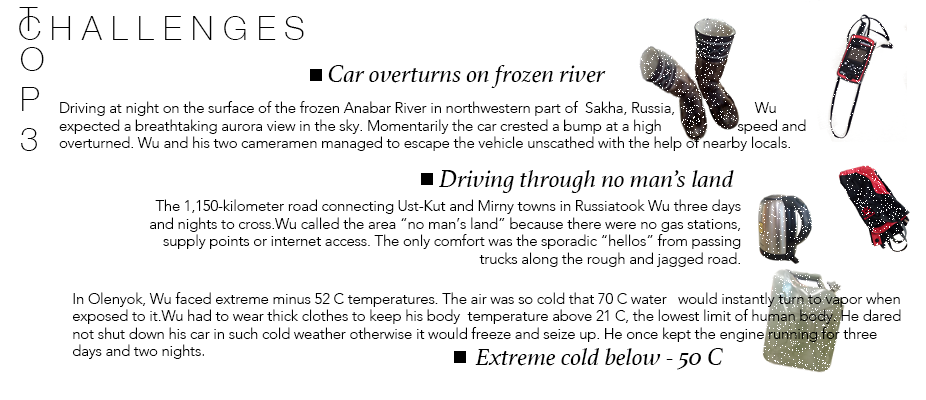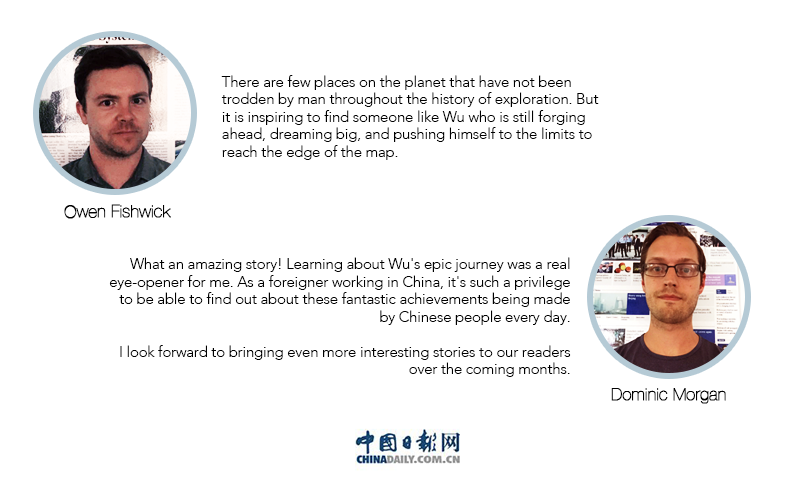Chinese explorer's incredible arctic journey
By Cao Yinan Updated: 2017-04-13

reezing minus 55 C winds whip the rolling sea into frothy peaks. Snow crackles and crunches underfoot, as brilliant white plains blend with the sky above. This is the Arctic Circle, and Zhanjiang-born Wu Yu has just become the first person to ever drive here from China, some 8,000 kilometers away.
Sitting on the hood of his icicle-encrusted Toyota Landcruiser, staring out across the Arctic Ocean, Wu realizes a dream he had since a child to combine his two passions in life – cars and exploration.
 love using wheels to measure the world and explore," says Wu from within his extreme weather polar jacket.
love using wheels to measure the world and explore," says Wu from within his extreme weather polar jacket.
The founder of a driving club in Beijing, Wu, 33, has driven through 20 countries, totaling 150,000 kilometers, the equivalent of driving around the earth's equator almost four times.
Like the famous Norwegian explorer Roald Amundsen who was the first to reach the South Pole back on Dec 14, 1911, Yu has lived his life establishing his own firsts. He was the first Chinese to drive to Russia's wild and unknown Kamchatka region, and the first driver of a Chinese license-plated car to drive to Russia's Oymyakon, one of the coldest permanently inhabited locations on Earth, twice.
For this adventure Wu's mission was clear. Set out from Leizhou Peninsula in Zhanjiang on the shores of the South China Sea and drive north through China, Mongolia, and Russia until hitting the Arctic Ocean in the polar far north.
Setting out from China's very southern tip on Jan 20, preparations for the month-long journey north were extensive.
"We spent weeks and weeks preparing and planning, making sure we had enough food, water, gas, and spares," Wu says. "We also spent a lot of time studying the journey and preparing for any problems along the road."

Crossing South China's mountainous lush-green landscape proved easy on the first leg, thanks to China's extensive investment in the road network in that part of the world, but Wu knew that it would get more difficult the further north he went.
"Generally, most roads in China are fine, the main expressways long and straight," Wu says. "However in Mongolia and Russia the roads can be unpredictable."

eaching the first milestone of the epic journey, Wu arrived in Beijing on Jan 24, after covering more than 2,500 kilometers in his first five days on the road.
While in the nation's capital, Wu met with Russia's ambassador to China, Andrey Denisov, who certified him as an envoy of cultural exchanges between the two countries.
Denisov said that it has been 68 years since China and Russia first established diplomatic relations and hoped for a great many more to come.
Hitting the road again, Wu headed northwest to the Chinese-Mongolian border, leaving the city behind in exchange for a more rugged landscape to whizz past the windows.
 oon the bumps of China's northeast flattened out to become Mongolia's vast, unending green plains. Then trouble struck. What was thought to have been a formality, turned into a headache at Mongolia's Zamen Ude border-crossing.
oon the bumps of China's northeast flattened out to become Mongolia's vast, unending green plains. Then trouble struck. What was thought to have been a formality, turned into a headache at Mongolia's Zamen Ude border-crossing.
"Officials at the border provided us with the wrong entry documents," Wu says. "So a few hours later we were stopped by the police and detained until the correct documents could be issued."
Putting the hiccup behind him, Wu arrived in the Mongolian capital Ulan Bator on Jan 31.
Crossing from Mongolia's forever-flat plains can be tiresome recalls Wu, the dead-straight roads stretching onwards to the horizon.
"To keep our spirits up and often time to keep us awake, we listen to local radio stations, and sometimes if the music isn't to our taste, we brought along plenty of Chinese music as well."
The days and miles ticked by, as the temperature began to fall the further north they travelled, finally reaching the Russian border. This time, all documents checked out, and Wu sailed into a land of ice and snow.
This is where the journey became difficult. Lake Baikal – the world largest, oldest and deepest freshwater lake dominates the landscape in southern Siberia.
Formed from a rift in an ancient valley, the immense body contains 20 percent of the world's unfrozen fresh water and sinks as deep as 1,642 m.
Choosing to avoid the lake, Wu instead decided to stick the road and cross the mountain ranges in Ulan Ude.
This proved impossible. Three meters of heavy snow had made the roads impassable, even for Wu's heavily modified vehicle equipped with four-wheel-drive and snow tires. On Feb 4, Wu was forced to turn back.
"There was no way to get through," Wu says. "So we had to return to the city and enquire about another way."
After speaking to local officials and guides in the city of Ulan Ude, there turned out to be one other way north that wouldn't lose them so much time as waiting for the snow to clear -- the lake.
For almost five months a year much of Lake Baikal's surface is frozen with many parts navigable by car. With the help of a local guide, Wu was escorted across the frozen blue lake.
 he majestic scenery in a world of white whirled by and as the mercury got lower and lower, so did the kilometers until Wu crossed into the Arctic Circle and made it to the Arctic Ocean.
he majestic scenery in a world of white whirled by and as the mercury got lower and lower, so did the kilometers until Wu crossed into the Arctic Circle and made it to the Arctic Ocean.
Finally on Feb 21, struggling for traction in the thick snow, Wu made it to Yuryung –Khaya, the northernmost village on the edge of the Arctic Ocean – the temperature outside: minus 55 C.
Mission accomplished. After 33 days, 8,000 kilometers and endless hours driving Wu Yu had become the first person to drive from the South China Sea to the Arctic Ocean.
The villagers expressed their great surprise at seeing Wu's white and red Toyota Landcruiser roll into town, where the main mode of transport is dog sleds.
With the help of a local English teacher, Wu sat down with Mayor Kanat Uskenbaevich over a plate of dried raw fish, a staple food of the village, who asked about customs and life in China and what was next for the explorer.
"In the next few years, I think I will be making quite a few more trips like this one," Wu says. "And of course, I will be looking at further and even more challenging journeys."
After the meeting, Wu headed to coast where he poured a small bottle of water he had carried 8,000 kilometers from the South China Sea, into the Arctic Ocean. He then refilled the bottle with Arctic seawater.
"To me it felt like a friendly swap," Wu says. "A symbol of healthy exchanges, communication, integration, and harmony between China and Russia." (Owen Fishwick, Cao Yinan)



